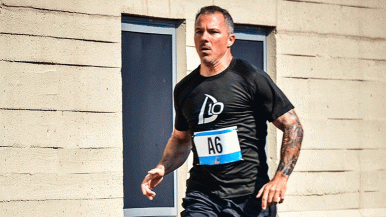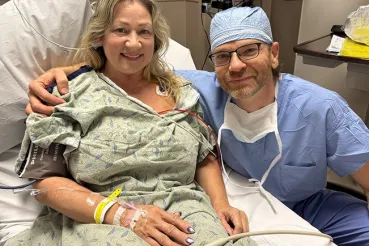Hip surgery wasn’t a present Mike Newman was expecting for his 40th birthday. But when the former professional soccer player’s persistent pain became too much to bear, he sought answers. He finally found them when he turned to sports medicine orthopedic surgeon Shane J. Nho, MD, MS, at Rush.
Now, Newman and his wife, Jaquelyn, are helping others find answers through their philanthropy —fueling Nho’s research to transform care for a painful hip condition that didn’t even have a name 20 years ago. Femoroacetabular impingement syndrome, or FAIS, is a hip abnormality that disproportionately affects younger, athletic people like Newman. Nho’s team in the Section of Young Adult Hip Surgery at Rush is an international trailblazer in studying and treating FAIS.
“My experience as a patient opened my eyes,” Newman said. “Learning how emerging this field is and knowing what the surgery at Rush has done for me is why we wanted to get involved and support this work. Dr. Nho changed my life. There are no two ways about it.”
Sidelined by pain
For roughly two decades, Newman’s life revolved around soccer. What began as an extracurricular activity in elementary school became a passion into adulthood, with Newman’s talent apparent on the high school field and in traveling leagues. At 18, he packed his bags for Brazil, joining a professional soccer club for a year before returning to his native Iowa to play collegiately.
At 5 feet, 9 inches tall and 160 pounds, Newman’s smaller size and unique speed were assets on the field, though he said they made him no stranger to athletic trainers and sports medicine physicians. His medical chart grew thick in his teens and twenties, undergoing eight different surgeries for a sports hernia and various injuries to his knees, ankles and groin.
After graduating college and briefly playing in the U.S. professional development league, Newman hung up his cleats to focus on running a construction consulting business and starting a family. He channeled his passion for athletics into running, biking, skiing, lifting weights and playing with his two young daughters. As he approached his late 30s, severe lower body pain put the former pro athlete on life’s sidelines.
“I wasn’t able to function on a day-to-day basis because of the pain,” Newman recalled. “My hometown is two-and-a-half hours from Chicago, and I couldn’t make that car ride without stopping for breaks to walk around. I was dealing with upset stomachs from taking so much Advil.”
Bewildered by the pain, Newman had a breakthrough when talking to another former soccer player who’d dealt with similar problems. “It sounds like your hips,” he told Newman, who was soon referred to Nho and his team at Rush.
Joined at the hip: FAIS and younger, active people
“Mike came in with pain that he’d been experiencing for years,” Nho said, describing Newman’s experience as typical among patients in his clinic. “Patients often have a hard time understanding where hip joint pain is felt in the body. Health care providers have a hard time diagnosing hip pain, too, though I like to think the field has gotten better over the past few years.”
Nho ordered X-rays and an MR arthrogram, an imaging test that involves a contrast injection into the joint, which confirmed three things: Newman did not have arthritis, but he did have FAIS and a tear to the ring of cartilage around the hip’s socket joint known as the labrum. He needed surgery to address his structural hip injuries.
First described in medical literature in 2003, FAIS is diagnosed when a patient has a bony overgrowth on the ball or socket parts of the hip joint — or both. While Nho said there is likely a hereditary component, a growing body of evidence suggests a developmental component makes people who are physically active during their growth spurt more susceptible.
“They could have had a more typical ball-and-socket in the past, but as they start doing repetitive physical activities — such as twisting, pivoting, running, jumping — the bone will change shape and become less spherical. Over time, this can lead to cartilage injury, labral tears and, subsequently, pain,” Nho explained.
While not everyone who has FAIS experiences pain, current studies suggest about 20% of the U.S. population may have the condition, and it is strongly associated with hip osteoarthritis later in life if left untreated.
Three weeks after his 40th birthday in 2014, Newman underwent surgery to correct the FAIS and repair the labrum in his left hip. Nho and his collaborators helped pioneer the arthroscopic surgical technique used to repair FAIS, having spent long days in Rush’s Sports Medicine Research Lab to simulate and study the approach. A successful surgery and rehabilitation process for the left hip gave Newman confidence to surgically repair the right hip three years later, and he’s grateful he did.
“Now I’m able to play with my kids again,” said Newman, now 48, who has resumed his favorite athletic activities without pain. “I can do the things I want without restrictions. I’m the result of Dr. Nho’s work.”
Giving back to move the bone and joint field forward
Newman and his wife established the Jaquelyn M. and Michael B. Newman Fund for Orthopedic Research in 2018 to fuel more innovation that will help others with similar orthopedic problems. With resources from the fund, Nho’s team built a growing registry of over 3,500 patients treated for FAIS, including Newman himself, who are followed over time. In Rush’s state-of-the-art Motion Analysis Lab, they are studying patient biomechanics before and after FAIS surgery to further enhance the clinical approach and rehabilitation protocols.
“Without donors like Mike and Jaquelyn, there’s no way we could do what we do,” Nho said. “Any time we’re investing in research, it requires a tremendous amount of resources — personnel, testing equipment, data analysis and so forth. Due to their contribution, we have the largest data repository on patients with FAIS that we know of in the field.”
Nho’s team is using these data to shape research grant submissions. In the past year alone, they published nearly 50 peer-reviewed articles on the work.
“The main objective of our gift is to make people’s lives better,” Newman said. “This is the intention of science and technology in the medical field — to extend our lives and the joy we experience.”
To learn more or make a gift that drives better outcomes for people of all ages with bone and joint conditions, contact Derek Lambert, senior director of development, at (312) 942-6289 or derek_lambert@rush.edu.
(Photo caption: A year after hip surgery that he described as “life-changing,” former pro soccer player Mike Newman participated in a 2018 decathlon-style event in support of Rush. Newman and his wife, Jaquelyn, have established a special donor fund to fuel the research of his surgeon Shane J. Nho, MD, MS, a specialist in treating painful hip conditions that tend to affect younger, active people.)




